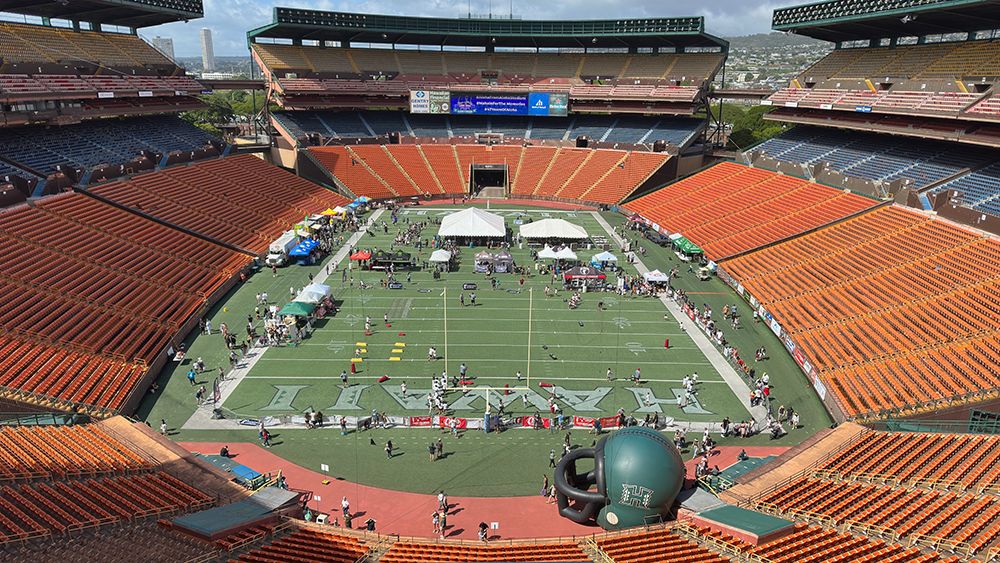HONOLULU — On Saturday, generations of Aloha Stadium fans attended the “Aloha from Aloha Stadium” event to bid farewell to a familiar venue that many have called a second home over the years.
As people filtered down the halls filled with historic memorabilia, voices could be heard sharing experiences, favorite moments and the occasional, “You guys lost dat game!” followed by laughter. Many wore the familiar green University of Hawaii colors and regalia.
In the day’s lineup: nostalgia. Lots of it — memories of pee wee, high school, college and pro football games, baseball games, pro soccer games, high school graduations, high school band performances and so much more. Also getting the chance to walk onto the field, the same way UH football players have done for years through the inflatable helmet, yeah, that was cool too.
The Aloha Stadium is more than just a sports venue. Thousands of isle residents and visitors have walked through its gates over the years in different capacities.
Ryan Andrews has held different positions over his eight years at Aloha Stadium — first as assistant events manager, then deputy stadium manager, and now stadium manager since 2021.
“Humans crave shared experiences, and this was a place you could get that. This place is unique because it is a community venue,” said Andrews in an interview with Spectrum News Hawaii.
"In most stadiums around the world, people go as just a visitor or a fan. Here, people also have participated in events. Some were players on a youth football team or high school or even UH, if they're fortunate enough. Perhaps they participated in a halftime show as a performer. School band events were held here so it might have been a marching band event. Thousands of people were runners who finished the Great Aloha Run on this field. And then thousands of students walked across the field while their parents cheered proudly in the stands as they graduated from high school.
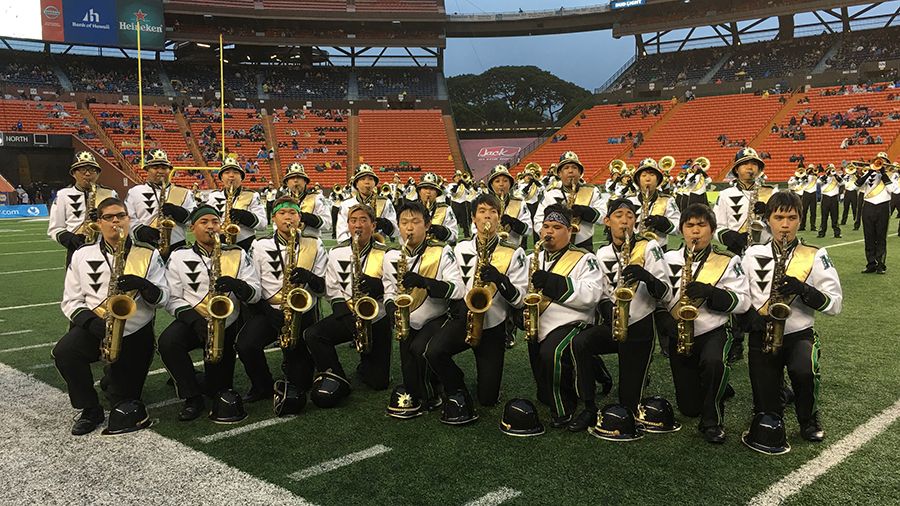
“There are so many memories that people hold that mean so much to them,” Andrews said. “And that's part of this venue. It's a community venue. What I think I'm so proud about today (is) watching these people come through and hearing their stories. It's amazing.”
Andrews said he had just met a man who flew in from Pennsylvania who claimed to have thrown the first touchdown at the stadium when the first high school game was played here.
He added, “I think what's also unique and not talked about a lot is this is the most isolated stadium in the entire world. Yet, it has hosted the greatest talents that this world has ever known. And again, you think about it from a football standpoint, NFL All Stars; baseball, to have professional baseball and even major league baseball games. Soccer, Pele played here, I think early in 1976. Professional rugby, it's had Monster Truck. I mean, this (stadium) has hosted everything. And then with concerts, everyone from Frank Sinatra and The Rolling Stones to U2, the Eagles, Michael Jackson, Janet Jackson, Celine Dion, Whitney Houston, and of course, Bruno Mars, it goes on and on. This place has done its job. Despite a lot of the challenges that we've had with this structure, it's done its job. It’s served as that gathering place for 47 years.”
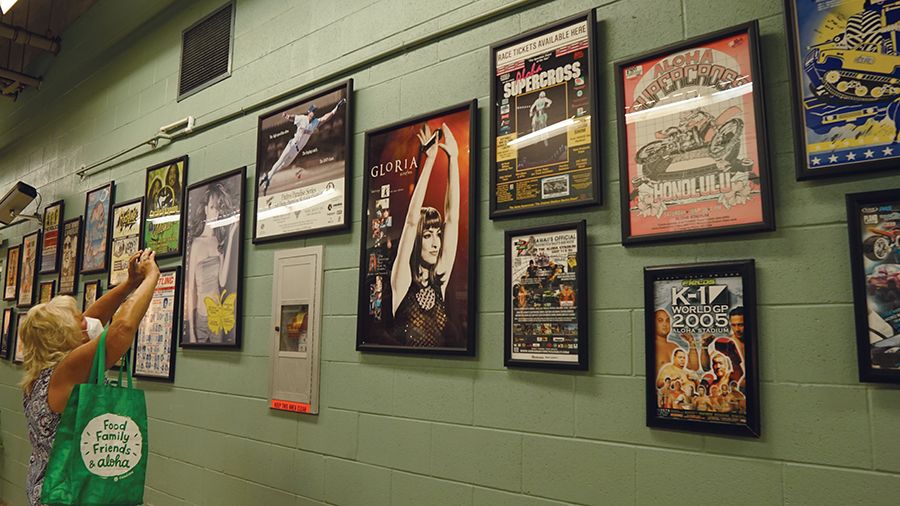
Norris Birdsong came with his son, Norris Sean Birdsong, and his wife. The elder Norris had a winning career playing with the University of Hawaii Warriors from 1975-1976. That season, he led UH in rushing with 731 yards on 165 attempts for a 4.4 yards-per-carry average and scored six rushing touchdowns that year. He also led UH in all-purpose yards in the same year with 892. To top his career off, Birdsong scored seven touchdowns in 1976 to lead UH in scoring with 42 points, and he shares the UH record for consecutive 100-yard rushing games of four, with three other players.
“I played with the University of Hawaii in 1975 when this stadium first opened up, and I’m here to celebrate, you know, all the 47 years,” said Birdsong. “I’m thankful to be here with my son and my wife, just grateful that God blessed me to come to Hawaii, and all the success I had on the football field and success off the field. And I think it’s a good time right now for a celebration, but what I do hope is that it doesn’t take long to rebuild a new stadium. Because if it takes years and years, it’s gonna be sad because all the history of this stadium with all the love the people put into it, it’s sad to see the stadium go, but it’d be great to see the new one. I just pray and hope it just doesn’t take too long to get that accomplished.
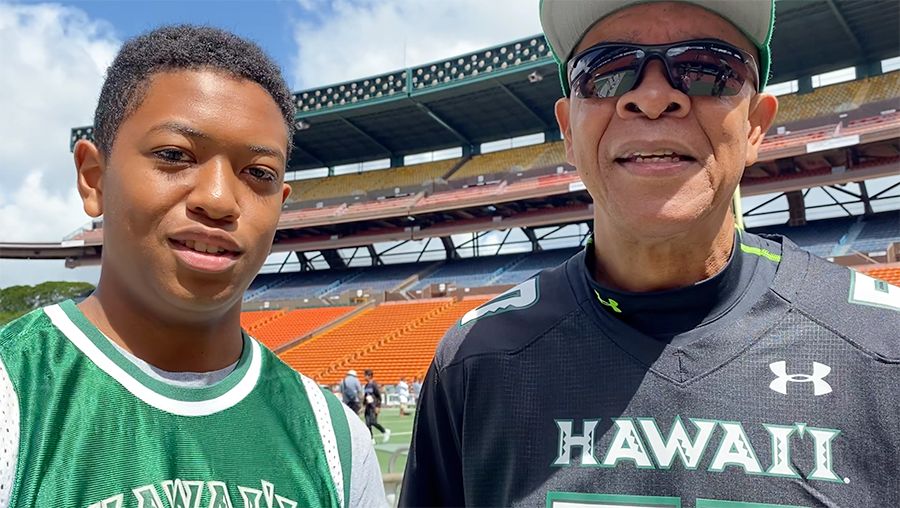
“I really wish they could’ve stuck with the original plan instead of tearing this stadium down and just remodeled it because there’s so much history with the Pro Bowls, all the players, with the coaches, June Junes, all my friends that have gone on, star players, Gary Allen, and all the players now,” added Birdsong. “It’s a lot of history in this stadium. If I had any say so, I’d just remodel this stadium and keep the history here, in Hawaii. You know, they tore down the old stadium and put hundreds of thousands of dollars into this stadium. It was a beautiful stadium, and still is. It’s just sad to see it go down because I already know it’s gonna be years and years before the new one comes up. I think if they renovate this, because they already have the structure, to me, it would just make more sense. That’s just my opinion.”
Roland Ige came with his buddy Tim Cockle, who was visiting from Georgia. “Okay, my worst memory is when they built the stadium, I couldn’t ride my bike from here to Radford,” said Ige, laughing. “But other than that, was great, all the sports.”
Cockle said, “I’m from Hawaii, originally, but I live in Georgia now. I just happened to be in town when they had this, so I had to come. I remember going to UH football games, Pro Bowl, Aloha Bowl, gone to a lot of events here, so really gonna miss it. And you know always gotta go to the Swap Meet! We’re gonna miss it, but lookin’ forward to the new. You hate to lose the old, but sometimes the new is really nice, so lookin’ forward to comin’ home again and see what’s gonna be ahead.”
“And tell the governor, hurry up with the new stadium,” said Ige, who added he's “not related to the (former) governor.”
Attending the event together with his wife, Flori-Ann, Mike Jocson from Kaneohe was a second-generation employee of Aloha Stadium. His mother was an usher in the late 70s and early 80s.
“I was an Aloha Stadium Jumbotron crew member for 11 solid years,” said Jocson. “I was a grip, camera operator, replay (tape operator), director and producer. My greatest memory is when Timmy Chang broke the passing record and when the Rainbows had that great season in 2007 going to the Sugar Bowl. My hope for the future of the stadium is that the next stadium will be just as multi-functional as this stadium is with the smarts for soccer, baseball, football, and I hope it’ll last another 50 years.”
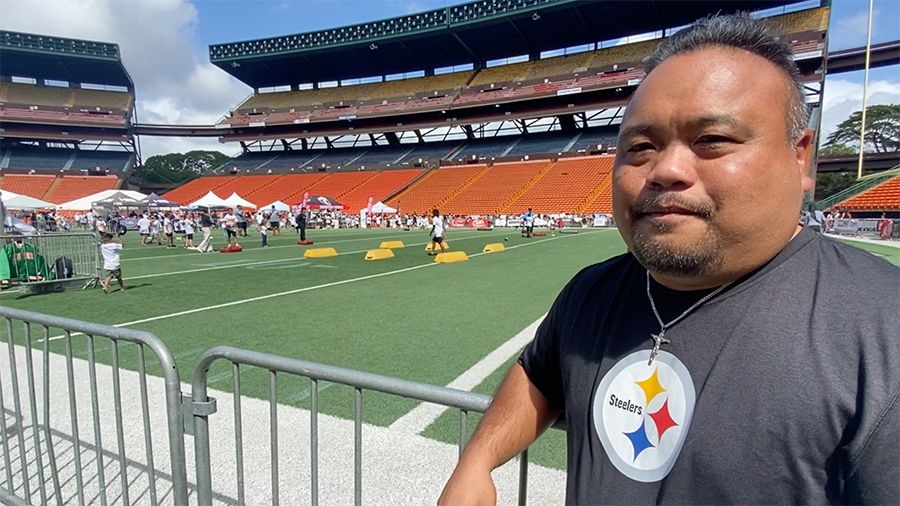
On his Facebook page, Jocson wrote, “Tons of great memories in this place. Pee-wee football games are where we train new Jumbotron crew members in different positions. When the cameras would lose sight of the ball with hidden ball fakes and followed the wrong player, we nicknamed it, ‘getting pee-weed’ or ‘you got pee-weed.’ We had a blast over the headset on our crew channel during most games with back-and-forth banter, but we buckled down and brought our “A” game and were very professional when it came down to the big games — Hawaii football, Pro Bowls, Hawaii Bowls, MLB baseball, soccer, baseball, graduations. We helped a couple get engaged on a private stadium tour. He wanted to use the Jumbotron message board and sound system. I had to loop Train’s ‘Marry Me.’”
“I worked with a lot of great people,” continued Jocson. “I hope the new stadium will bring many memories and events to come. Farewell to this version of Aloha Stadium.”
Albert Matuti from Halawa has had season tickets for UH games since “the days of Larry Price.” He said, “This place holds a lot of memories for us … UH football, high school football, all the stuff like soccer. One thing I remember we were here for the game against Washington that ended up with Hawaii ending in a regular season unbeaten record that earned their trip to the Sugar Bowl.”
Gwen Nakamura is the assistant band director at the University of Hawaii at Manoa and has been in the program for 33 years. She coordinated the Rainbow Invitational Marching Band Festival that started nearly 42 years ago that was held at the stadium. The non-competitive event showcased anywhere from 16 to 18 high school marching bands, even hosting a few from the U.S. Mainland and Japan.
“The biggest challenge was to make sure, with so many groups, that everything ran smoothly. Honestly, our UH marching band students helped escort and worked hard, and the stadium staff was always so helpful with everything,” said Nakamura. “The greatest joy was to see all the high school bands come and participate, and have fun. It was always fun for the UH band to perform for the high school students. The stadium has been so many things for so many people. I wish we could march in it one more time.”
Ivan Nishimura has been with Aloha Stadium’s scoreboard department since 2004, running the department for about the last 10 years. “Favorite moments? As a fan, there’s gotta be moments from the 70s when the stadium first opened with Pele, the Hawaii Islanders and the first Pro Bowl. I’ve gone through a lot of events meeting different celebrities, football players, and got to meet Doug Flutie, Warren Moon, Al Michaels, who used to be the broadcaster for the Islanders back in the late 60s and early 70s. I got to witness a lot of big concerts like Bruno Mars. It’s been kinda neat working here.”

As for the future, he said, “We’re hoping for a nicer house and something with more tech stuff to make it more fan friendly. I think everybody’s just waiting to see what the new house is going to be.”
Along with the day’s visitors, Andrews recalls one of his favorite memories. “My favorite memory isn't a sport. It wasn't a concert. It actually was Willie K. singing the national anthem and ‘Hawaii Ponoi,’ and I believe it was the 2018 Hawaii Bowl. Just him, an ukulele and his angelic voice. And I still get chills — right now I’m getting chicken skin just talking about it, because it's just so beautiful.”
One of the biggest challenges for Aloha Stadium, Andrews said, “The fact that there was never any money to maintain this place properly. You know, and that's obviously why we're here today.”
He explained in 2017, the state conducted a conceptual redevelopment study for the stadium that showed it would cost more to renovate and bring the facility up to code compliance, such as with ADA. That’s when the decision was made to level the structure and build new. Andrews likes the idea of building a smaller, multi-use facility.
“One of the challenges we had here is that the field is meant for football. It's narrower than a soccer field, narrower than a rugby field, so you actually can't play regulation, rugby and soccer on this field,” shared Andrews. “When they played here, they had to agree to play to a narrower field.” So the new stadium, Andrews said, will have a wide enough field to accommodate all sports that play in a rectangular field — soccer, rugby and football. “I look forward to seeing modern-day amenities and seating options, and not just regular seats, but club spaces, suites, a variety of food. So that's what we're going for, a modern-day stadium, smaller but modern.”
Andrews isn’t sure when the demolition process will begin, though getting rid of inventory has started through an auction. In one area, people could bid for black-and-white enlarged images or chairs. But the memorabilia will be kept for the new stadium.
He also said the Swap Meet will continue, moving into the upper Halawa Lot with parking in the lower lot. Other large events will also continue in the parking lot until the new venue is built.
When asked about how long he thinks the construction of the new facility will take, Andrews said, “That’s the million dollar question. I don’t know. That’s a question our elected leaders need to resolve.”
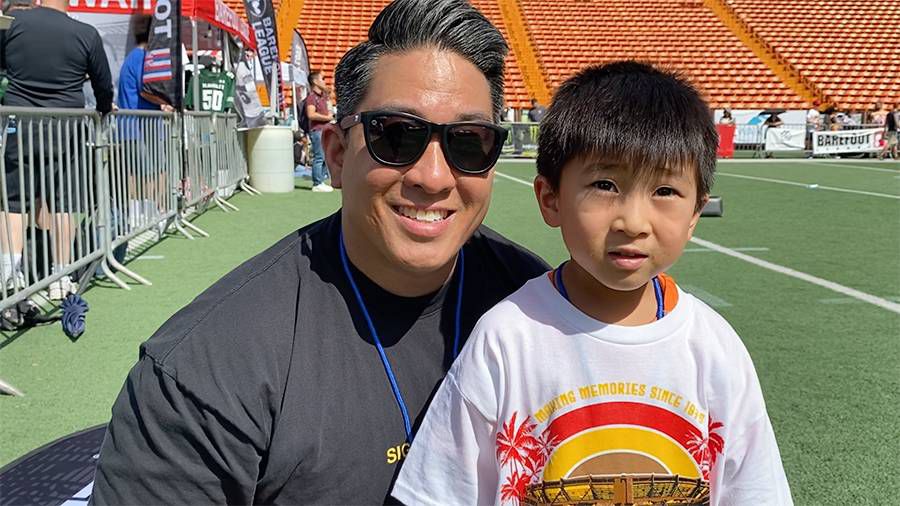
Back on the field, Ken and his wife from Ewa joined the day’s fun with son Mason in tow. Mason had just finished taking part in the football drills and runs with other keiki conducted by the Barefoot League. “I’m from Ewa and I had fun,” said Mason before running off. Said Ken, reaching for his son, “I’m bringing my son to enjoy the Aloha Stadium goodbye.”
Chris and son Zane from Pearl City had just arrived on scene, ready for Zane to get in on the football fun. “We’re here today just to say goodbye to Aloha Stadium and all the memories that we’ve had through all the years. This is his first and probably last time here, so wanted to show him what Aloha Stadium is and what it was before the new stadium is built.”
With some coaching from his dad, Zane said, “I’m excited.”
Chris added, “Alright, let’s go do some fun things. Can you say goodbye Aloha Stadium?”
Dutifully, the boy replied, “Goodbye, Aloha Stadium!”
Sarah Yamanaka covers events, environmental and community news for Spectrum News Hawaii. She can be reached at sarah.yamanaka@charter.com.
EDITOR'S NOTE: The original article has been updated to correct the spelling of Mike Jocson and his positions at Aloha Stadium. (Feb. 26, 2023)



